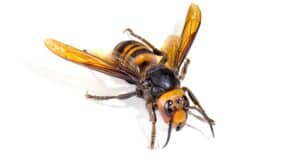When you see a wasp flying toward you, what do you do? Most people’s first instinct is to run away screaming, and it’s easy to see why. They inflict a vicious sting, and some pack so much venom that even a few stings can kill a person. However, wasps also serve an important role in the ecosystem. They pollinate flowers and trees, and help to reduce the populations of common pests and other invasive species. While they may appear scary, there is more to them than meets the eye.
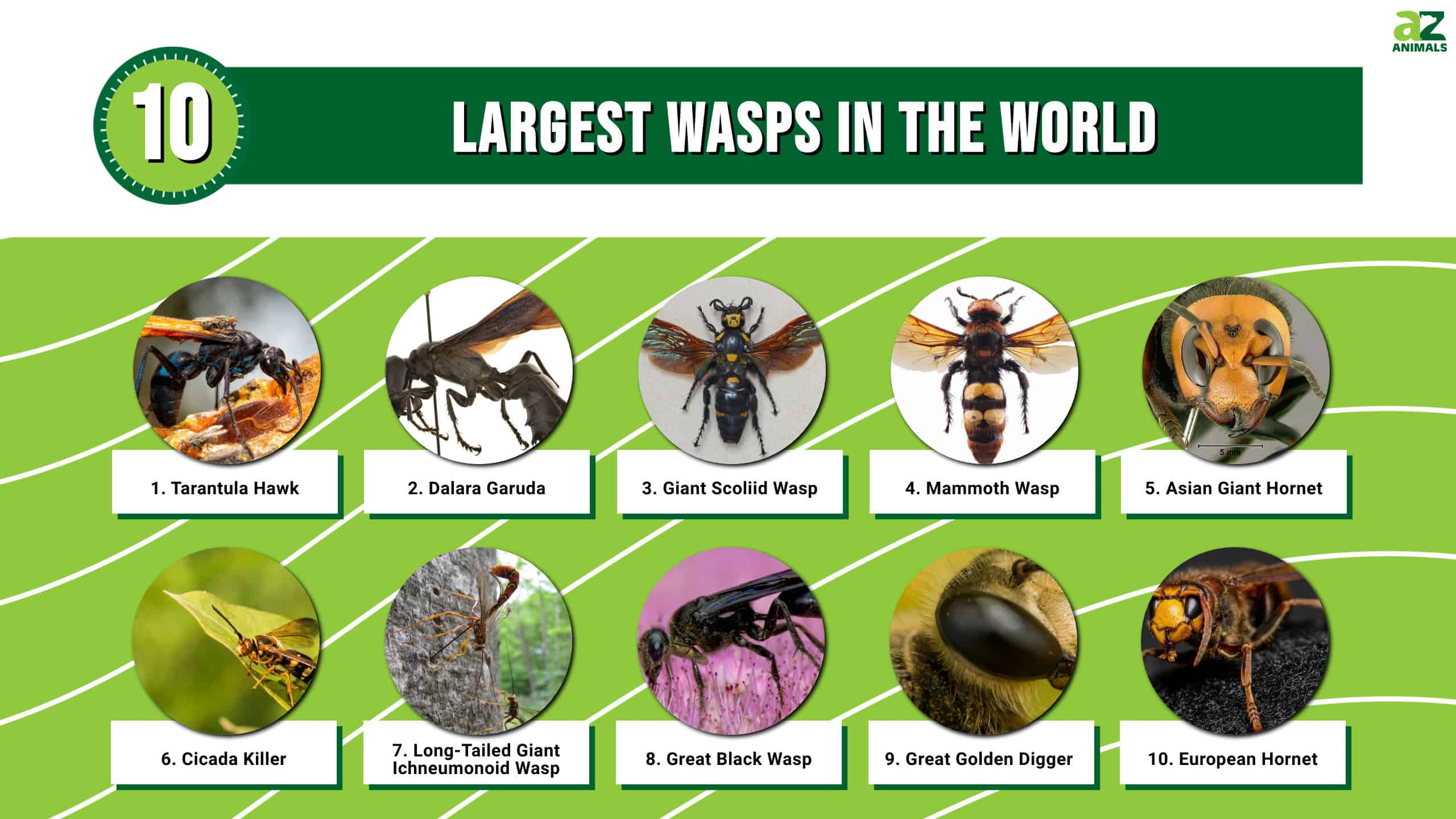
Wasps and their close cousin the hornet share a common ancestor with bees and ants. Some species are eusocial, with members of a nest working and living together, while others live mostly solitary existences. Although most act as pollinators, many also capture and eat other insects. They come in all shapes and sizes, from tiny little fairy wasps to the giant hornets of Asia and Europe. But which species of wasp is the largest? To determine which wasps are the grandest of them all, it’s essential to measure their length from head to stinger. Here is a list of the 10 largest wasps in the world.
10. European Hornet

European hornets can quickly turn aggressive
©Rytis Bernotas/Shutterstock.com
The European hornet (Vespa crabro) is the largest eusocial wasp native to Europe. In addition, it’s also the largest true hornet in North America. Although it looks similar to the Asian giant hornet, it is much smaller in size. On average, workers measure around 1 inch in length, but queens can grow up to 1.37 inches long. Their abdomens contain brown and yellow stripes, while the wings appear reddish-orangish. Most people view European hornets as pests, but in general, they tend to avoid humans. However, they can quickly turn aggressive if you threaten their nests or get too close to their food sources.
While they traditionally come from Europe, their range extends to Japan and throughout North and Central America. Their diet is mainly carnivorous, consisting primarily of beetles, moths, dragonflies, mantises, and other wasps. However, they will also consume fruit and other high-sugar foods and steal prey from other insects. Due to the widespread destruction of their nests, the IUCN lists European hornets as threatened or endangered in certain regions.
9. Great Golden Digger

Great golden diggers are found across the Americas
©Steven Ellingson/Shutterstock.com
Also known as the great golden sand digger, the great golden digger wasp (Sphex ichneumoneus) is part of the Sphecidae family. It gets its name from the golden pubescence on its head and thorax and because it digs burrows in sand. At their largest, they can reach up to 1.5 inches in length, with females measuring bigger than males. In general, they tend to mind their own business and do not act aggressively toward humans.
Great golden digger wasps range throughout North, Central, and South America. They congregate around parks and meadows where flowers grow. Unlike eusocial species, great golden digger wasps are solitary insects. Their diet primarily consists of nectar from flowers, but they will also capture and paralyze katydids and crickets. Gardeners often express affection for them because they aerate the soil with their tunnels and remove pests. As of yet, the IUCN has yet to evaluate its conservation status.
8. Great Black Wasp
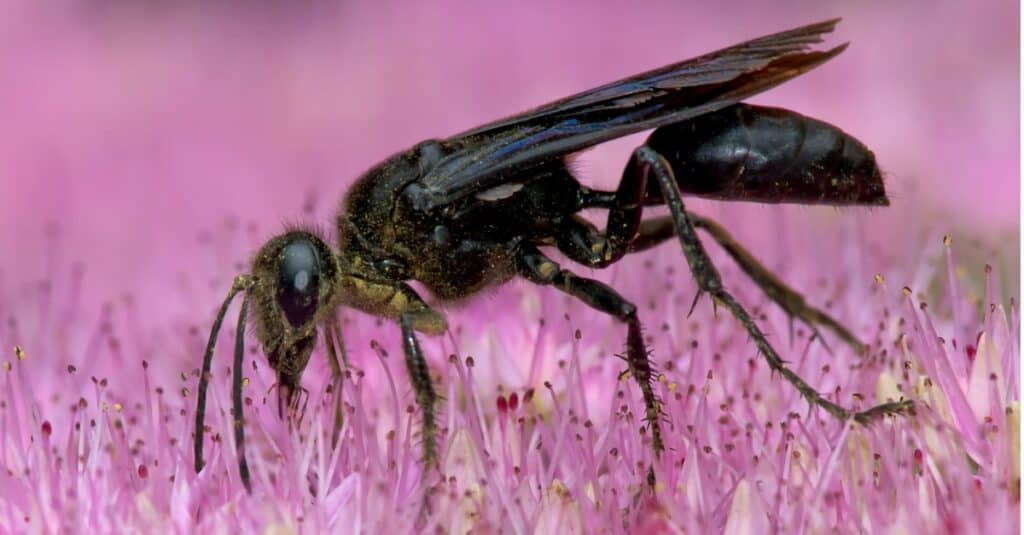
Great black wasps can reach 1.4 inches in length
©Paul Reeves Photography/Shutterstock.com
As its name implies, the great black wasp (Sphex pensylvanicus) is a large species of wasp. It can grow up to 1.5 inches in length, although most average between 0.8-1.4 inches. As with most wasps, the female typically measures larger than the males. Their bodies are jet black, while their wings appear bluish-purple. Although their sting is quite painful, they pose little threat to humans.
The great black wasp is distributed throughout most of the United States and northern Mexico. Its scientific name indicates alludes to its American origins, as the word pensylvanicus translates to “native to Pennsylvania.” They belong to the digger wasp family, and build their nests in underground tunnels. Their diet includes grasshoppers, cicadas, locusts, and katydids, which they also feed to their larvae. Currently, the great black wasp is not listed by the IUCN as a species of special interest.
7. Long-Tailed Giant Ichneumonoid Wasp
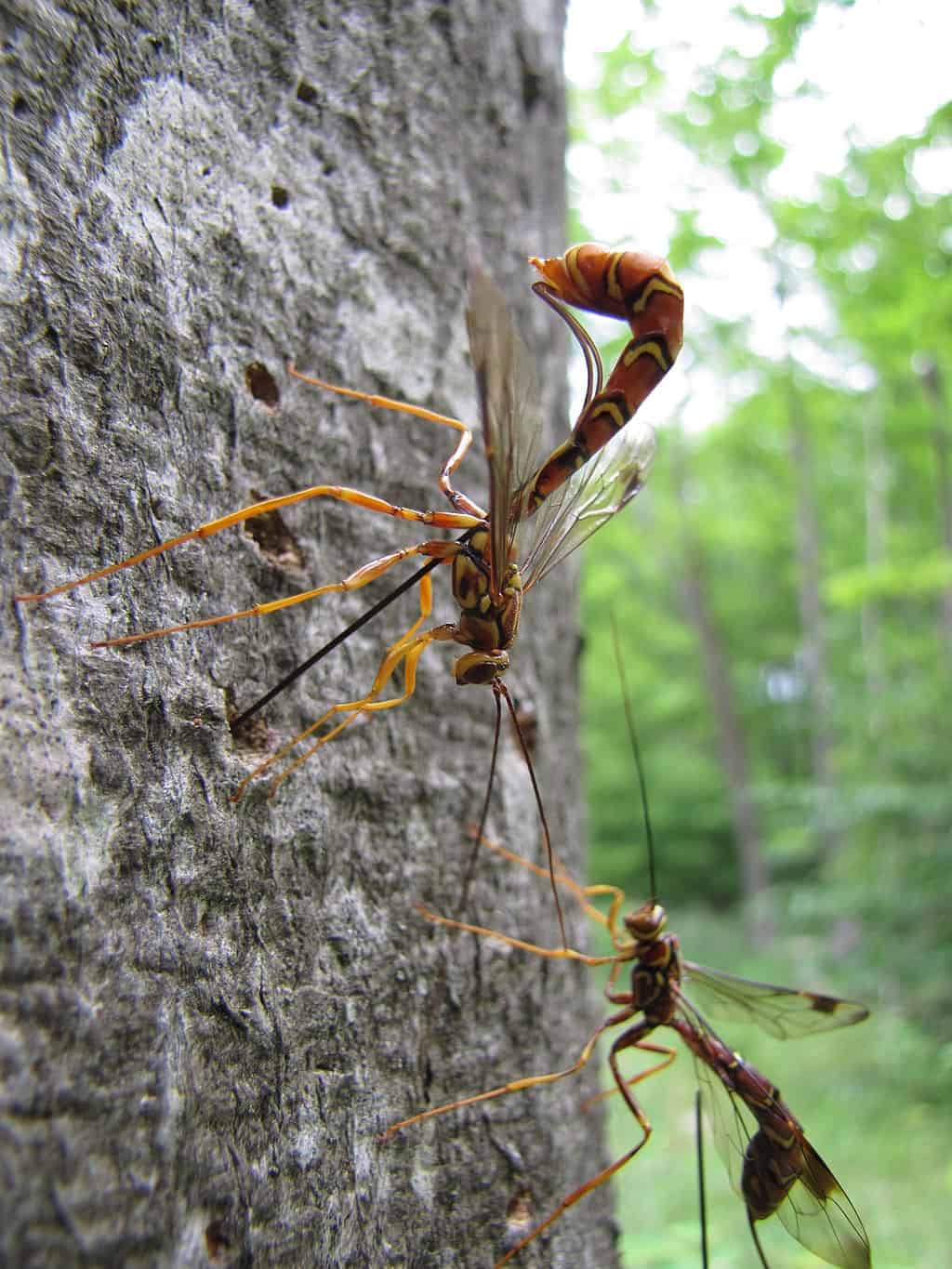
These wasps are harmless to humans.
©Seney Natural History Association, CC BY-SA 2.0 <https://creativecommons.org/licenses/by-sa/2.0>, via Wikimedia Commons – License
The long-tailed giant ichneumonoid wasp (Megarhyssa macrurus) is one of the largest species in the Ichneumonidae family. Females can grow up to 2 inches in length, while their ovipositor can reach 4 inches in length. It gets its scientific name from the Greek words makrós, meaning “long,” and oùrá, meaning “tail.” Their body is reddish-brown with black and yellow-orange stripes, while the wings appear transparent. Unlike most wasps, they do not sting and pose no threat to people.
Long-tailed giant ichneumonoid wasps live in the eastern half of the United States. Their most distinguishing feature is their ovipositor, which females use to deposit their eggs. As a parasitoid, it breeds by injecting its eggs into the larvae of pigeon horntails. After a few weeks, the wasp larva will consume the host and pupate before emerging as a fully grown adult. The IUCN does not list the conservation status of long-tailed giant ichneumonoid wasps.
6. Cicada Killer
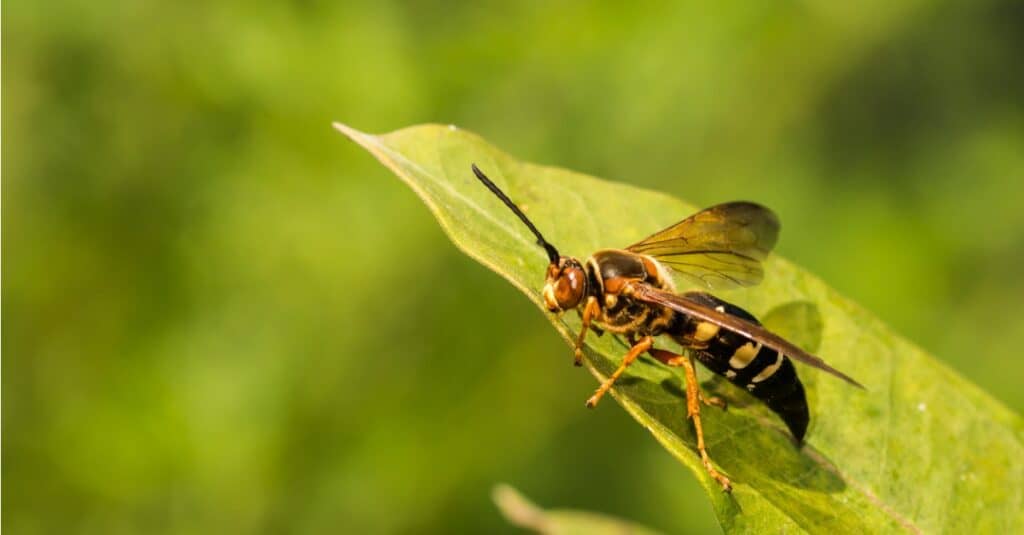
Cicada killers can grow up to two inches in length
©iStock.com/JasonOndreicka
Also known as the cicada hawk, the cicada killer (Sphecius speciosus) is a large, solitary species of digger wasp. It occasionally goes by the name Eastern cicada killer or a sand hornet, despite not belonging to the hornet family. Sizes vary greatly, with specimens ranging from 0.6-2.0 inches long. Reddish hair covers their black-striped thoraces, while their wings appear brown. Despite their fearsome name and appearance, they do not pose a direct threat to humans. They rarely attack people, and their sting is less painful than other, more venomous species.
Cicada killers live throughout the eastern and central United States, Mexico, and Central American. They get their name from the fact that the females hunt cicadas, which they feed to their larvae. Meanwhile, adults subsist solely on the nectar from flowers. Thanks to their efforts at reducing cicada populations, cicada killers indirectly benefit deciduous tree populations upon which cicadas feed. Due to their widespread population, the IUCN does not grant them any special status.
5. Asian Giant Hornet
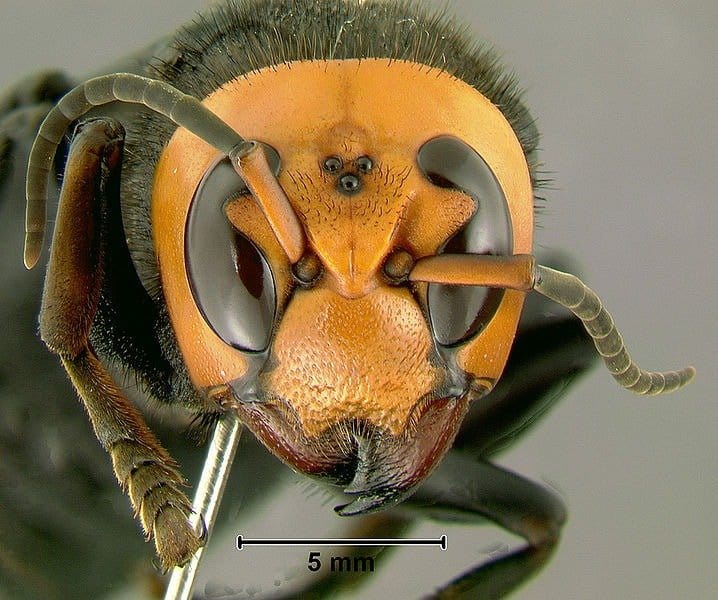
Asian giant hornets sightings have occurred across the Pacific Northwest in recent years
©Gary Alpert / CC BY-SA 3.0 – License
Also known as the Japanese giant hornet, the Asian giant hornet (Vespa mandarinia) is the world’s largest hornet. They can grow up to 2.2 inches long, and their wingspan measures over 3 inches. Their distinctive orange head and brown body make them easily recognizable even among the thousands of species of wasp. In addition to their common and scientific names, they also go by the more sinister “murder hornet.” This is due to their venomous sting, which is deadly enough to kill a person given the right dosage.
The Asian giant hornet is native to east and southeast Asia as well as the far east of Russia. However, confirmed sightings in North America in the past few years indicate its territory is expanding. They prefer to build their underground nests in forested and low mountainous areas. Its diet consists of large insects, honey, and tree sap. The IUCN lists the Asian giant hornet as Threatened due to habitat loss caused by deforestation.
4. Mammoth Wasp
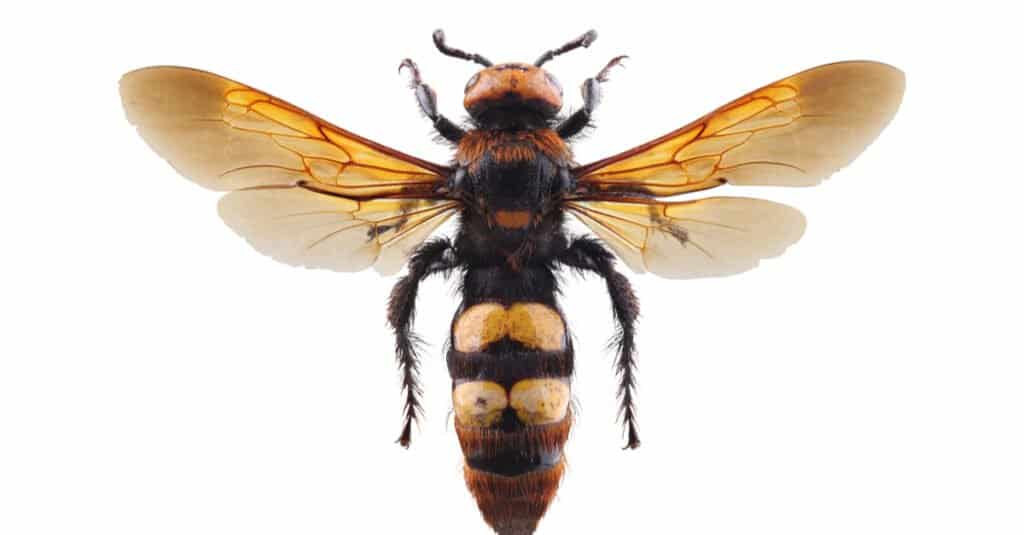
Mammoth wasps can reach 2.4 inches
©Vitalii Hulai/Shutterstock.com
The mammoth wasp (Megascolia maculata) is the largest wasp found in Europe. Females can reach up to 2.4 inches in length, although males generally measure much smaller. Similar in appearance to a stretched-out bumblebee, glossy black hair covers their yellow and black striped bodies. Despite their large size, their sting is relatively harmless to humans, and they rarely act aggressively toward people.
Mammoth wasp populations live throughout southern Europe and Russia, North Africa, and the near east. It prefers Mediterranean habitats such as oak forests and dense shrublands. You can also frequently find them around compost heaps and sawmills, which attract their prey. Adults feed on the nectar of flowers, while females lay their eggs on the larvae of the European Rhinocerous beetle, its sole known host. The IUCN does not provide mammoth wasps with a special status.
3. Giant Scoliid Wasp

©revers/Shutterstock.com
The Giant Scoliid Wasp (Megascolia procer) is one of the largest wasps in the world. A solitary species belonging to the family Scoliidae, they can measure up to 2.5 inches in length. In addition, their wingspan can reach up to 4.5 inches long. Their bodies tend to look black and feature yellow and orange markings. Like most other parasitoid wasps, they will only sting humans if they feel threatened.
The Giant Scoliid Wasp is native to the Indonesian islands of Sumatra and Java. Females prey on the Atlas beetle, which they paralyze and bury in an underground cell. The female’s egg germinates inside the beetle until it hatches and proceeds to consume its still-living host. As of yet, the IUCN has not evaluated the conservation status of the Giant Scoliid Wasp.
2. Dalara Garuda
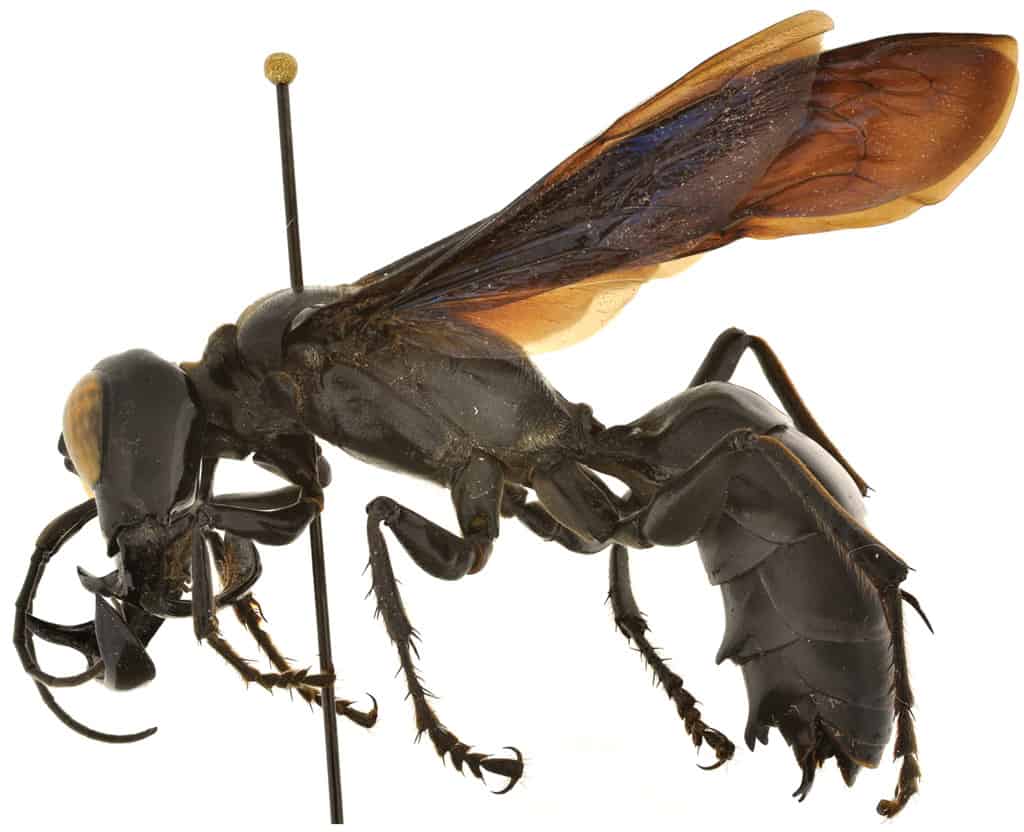
No live specimens have been recovered of
Megalara Garuda.
©L. Kimsey and M. Ohl (2012). “Megalara garuda, a new genus and species of larrine wasps from Indonesia (Larrinae, Crabronidae, Hymenoptera)”. ZooKeys 177: 49. DOI:10.3897/zookeys.177.2475., CC BY 3.0 <https://creativecommons.org/licenses/by/3.0>, via Wikimedia Commons – License
Dubbed the “King of Wasps” after its discovery in 2011, Dalara Garuda (Megalara) is one of the largest wasps in the world. No live specimens have been recovered, but some found remains to measure up to 2.5 inches long. Unlike most species of wasps, the males look noticeably larger than the females. Their massive bodies are jet black, and the males possess long, powerful-looking jaws. The purpose of the jaws may be for self-defense or to hold females during mating.
To date, the only known habitat of Dalara Garuda is the Indonesian island of Sulawesi. It gets its name from Garuda, a part-human, part-eagle mythical creature that serves as the national symbol of Indonesia. They belong to the digger wasp family, implying that the females may sting other insects and use them as a host for their eggs. Due to its recent discovery, the IUCN has yet to evaluate Dalara Garuda’s conservation status.
1. Tarantula Hawk

Tarantula Hawks are such dangerous wasps that they are often seen consuming a tarantula spider.
©Sari ONeal/Shutterstock.com
The tarantula hawk is arguably the largest wasp in the world. These wasps are a type of spider wasp that specializes in hunting tarantulas. Many species can frequently measure up to 2 inches long, but Pulszkyi’s tarantula hawks (Pepsis pulszky) are easily the biggest of them all. They can grow up to 2.7 inches long, with a wingspan of 4.5 inches in length. Their coloration is typically blue-black, with rust-colored wings. Although they rarely attack humans, they deliver one of the most painful stings among all insects. Thankfully, the pain from their sting only lasts about five minutes. Few animals prey on tarantula hawks because of their large stinger, with the roadrunner being a notable exception.
Tarantula hawks’ territory includes India, Southeast Asia, Africa, Europe, Australia, and the Americas. Both male and female adults subsist on a diet of flowers, while only the females hunt spiders. They use their stinger to paralyze tarantulas before laying an egg inside their live host, which becomes food for their larva. Currently, the IUCN lists the tarantula hawk as a species of Least Concern.
Honorable Mention: Another Gigantic Wasp
If you thought there were only 10 enormous wasps flying about on the planet, think again! We’ve uncovered another huge wasp to add to our list that is noteworthy for its size.
Asian Hornet

The Asian hornet, also called the yellow-legged hornet, has a terribly painful sting.
©Brais Seara/Shutterstock.com
The Asian hornet, also called the yellow-legged hornet, is a different variety than the Asian giant hornet, but also imposing in size, able to grow to 1.2 inches long. Though they are most commonly found in Southeast Asia, these wasps have managed to find their way into parts of Europe, including Great Britain, where they are considered an invasive species.
Asian hornets have large stingers, and females will wield them in defense of their nests, which can result in a very painful sting. One Welsh woman stung by an Asian hornet made the local news, as the species seems to be attracted by the smell of beer to areas where people like to congregate and drink. The toxicity of the sting of an Asian hornet is greater than some other species, causing sharp pain that she described as “being stabbed by a red hot needle.”
Summary Of The 10 Largest Wasps In The World
| Rank | Wasp | Size |
|---|---|---|
| 1 | Tarantula Hawk | Can grow up to 2.7 inches long, with a wingspan of 4.5 inches in length |
| 2 | Dalara Garuda | No live specimens have been recovered but remains measure up to 2.5 inches long |
| 3 | Giant Scoliid Wasp | Can measure up to 2.5 inches in length, and their wingspan can reach up to 4.5 inches long |
| 4 | Mammoth Wasp | Females can reach up to 2.4 inches in length, males much smaller |
| 5 | Asian Giant Hornet | Can grow up to 2.2 inches long, and their wingspan measures over 3 inches |
| 6 | Cicada Killer | Sizes vary greatly, ranging from 0.6-2.0 inches long |
| 7 | Long-Tailed Giant Ichneumonoid Wasp | Females can grow up to 2 inches |
| 8 | Great Black Wasp | Can grow to 1.5 inches, most average between 0.8-1.4 inches. Females are larger than males |
| 9 | Great Golden Digger | Can reach up to 1.5 inches in length, females are larger than males |
| 10 | European Hornet | Workers grow to 1 inch, queens grow to 1.37 inches |
The photo featured at the top of this post is © Gary Alpert / CC BY-SA 3.0 – License / Original
Thank you for reading! Have some feedback for us? Contact the AZ Animals editorial team.





